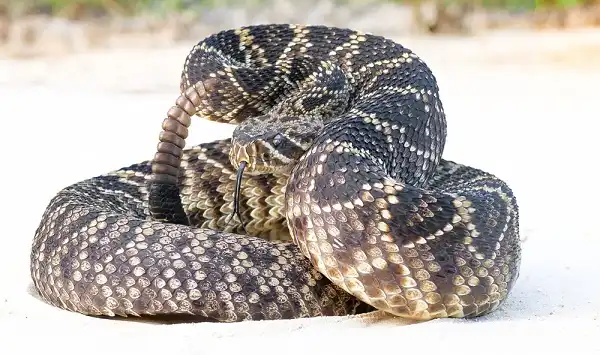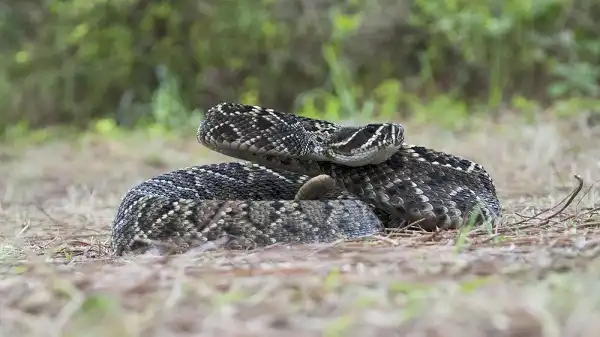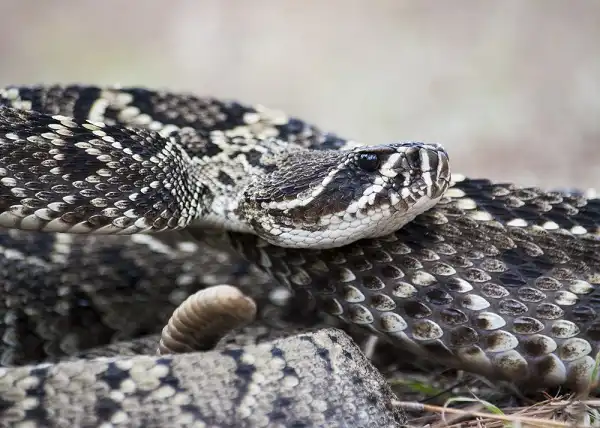Beware the Eastern Diamondback Rattlesnake: a vicious and deadly species of pit viper native to the Southeastern United States. This fearsome predator can grow more than 6 feet in length, leaving most potential predators intimidated and humans giving it plenty of space. Despite its reputation as an aggressive snake, the Eastern Diamondback is actually quite timid and would rather retreat if faced with a threat than resort to striking first – making it far less dangerous when given due respect! In this blog post, we’ll explore why the fear of the Eastern Diamondback Rattlesnake may be warranted but also how fascinating this creature truly is. Read on for more information about what makes this rattling reptile so unique!

Eastern Diamondback Rattlesnake Description
The Eastern Diamondback Rattlesnake (Crotalus adamanteus) is a species of large, venomous pit viper native to the southeastern United States. It is the heaviest and most dangerous of all rattlesnakes in North America. The snake’s body is covered in a pattern of 21-25 yellow or white diamond-shaped markings, outlined by deep black lines which give them their iconic namesake. The head is usually dark with a pale eye stripe on either side and features a distinctive rattle at the end of its tail. The Eastern Diamondback has a venomous bite that can cause intense pain, swelling, and other symptoms such as vomiting and nausea if left untreated. Thankfully, antivenin is available for humans who are unfortunate enough to be bitten by this animal.
Eastern Diamondback Rattlesnake Habitat
The Eastern Diamondback Rattlesnake is native to the southeastern United States but can be found in areas extending from South Carolina to central Florida and as far west as Louisiana. It typically inhabits a variety of habitats including pine flatwoods, maritime hammocks, hardwood swamps, and coastal sandhills – all of which provide plenty of shade and prey for the snake to feed on. Though it prefers warmer climates during the day, it is known to seek out cooler and shadier spots at night. In addition to its preference for warm climates, the Eastern Diamondback is also an excellent climber and can often be seen perched up in trees searching for prey or basking in the sun before retreating back down into cover. Its strong body allows it to move quickly between trees, making it well-adapted for hunting small mammals that frequent these environments. The snake’s reluctance to cross open areas helps it avoid potential predators such as hawks or other snakes that may otherwise prey on them.
Eastern Diamondback Rattlesnake Diet
The Eastern Diamondback Rattlesnake primarily feeds on small rodents such as mice and squirrels, though its strong jaw muscles allow it to consume larger prey like rabbits and birds. It has an ambush method of hunting, relying on its excellent heat-sensing abilities to detect prey in the dark. When a potential meal is detected, the snake will strike quickly and inject venom into the animal before constricting it tightly to break its bones or suffocate it. This venom also helps break down the animal’s tissues so that it can be swallowed more easily. In addition to their primary diet of small mammals and birds, Eastern Diamondback Rattlesnakes have also been known to eat amphibians, reptiles, fish, eggs, and even other snakes. While they typically hunt alone, they have been observed sharing meals with other rattlesnakes in rare cases – most likely due to competition for limited resources in certain habitats. The Eastern Diamondback Rattlesnake has an incredibly fast metabolism which requires them to feed frequently in order to stay energized and healthy – sometimes eating multiple meals per day depending on the availability of food sources in their environment.

Eastern Diamondback Rattlesnake Size
The Eastern Diamondback Rattlesnake is one of the largest and most formidable snakes in North America, reaching lengths of up to 8 feet and weighing up to 10 pounds. When fully grown, an Eastern Diamondback Rattlesnake can have a head that measures up to 2 inches wide and a girth around the midsection that may exceed 1 foot! While they are typically slender in shape, they can become significantly heavier during the mating season due to the added weight of eggs that females carry. In addition to its impressive size, the Eastern Diamondback Rattlesnake also has some remarkable abilities that help it survive in its natural habitat.
Eastern Diamondback Rattlesnake Lifespan
The Eastern Diamondback Rattlesnake has a relatively long lifespan for a snake species, with individuals typically living between 10 and 20 years in the wild. That said, there have been some verified records of specimens reaching up to 25 years old! In captivity, these snakes can live even longer; some older specimens have been known to reach more than 30 years of age. Captive-bred Eastern Diamondback Rattlesnakes also receive more consistent access to food, allowing them to reach their full growth potential without having to fight or compete for resources in their natural environment. In terms of reproduction, females typically produce between 6 and 10 eggs per clutch which take between 3 and 4 months to hatch. This species is ovoviviparous – meaning that the eggs are retained within the female’s body until they are ready to hatch. After hatching, young rattlesnakes will stay close to their mother until they grow large enough to hunt on their own – usually after 1 year of age.
Eastern Diamondback Rattlesnake Behavior
The Eastern Diamondback Rattlesnake has generally considered a relatively docile species and when threatened, they are far more likely to retreat than attack. Despite this, they can still be quite intimidating due to their size and the distinctive rattle at the end of their tail. When approached by potential predators or humans, these snakes will typically try to take advantage of their camouflage and remain motionless in hopes that their presence goes unnoticed. If further provoked, they may coil up and rattle their tail as a warning signal. If this does not work, the snake may even hiss, making it louder and more aggressive before finally striking out with its venomous bite if all else fails. In terms of social behavior, Eastern Diamondback Rattlesnakes are mainly solitary creatures who only come together during mating season.

Eastern Diamondback Rattlesnake Speed
Eastern Diamondback Rattlesnake speed is impressive – this species is capable of reaching speeds of up to 5mph (8km/h) when in pursuit of prey. Though they are rather slow when traveling on the ground, Eastern Diamondback Rattlesnakes make up for this with their agility – they can move quickly between trees and maneuver around dense vegetation with ease. This allows them to hunt small mammals such as mice and voles efficiently, making them well-adapted to their environment. In terms of defense against predators, Eastern Diamondback Rattlesnakes rely heavily on their venomous bite which can be used as an effective deterrent against larger predators such as birds of prey or foxes.
Eastern Diamondback Rattlesnake Hunting
Eastern Diamondback Rattlesnakes are formidable predators, relying on their speed and agility to hunt small mammals such as mice and voles. They typically hunt during the nighttime hours and have been observed to follow a stalking pattern that consists of stopping and starting – using their camouflage to remain undetected until they are close enough to strike. In addition to their camouflage, these snakes can also sense vibrations through the ground which they use to detect potential prey before striking. To further increase their hunting efficiency, Eastern Diamondback Rattlesnakes will sometimes coil up in tall grass or brush and wait patiently for unsuspecting prey. Despite being highly successful hunters in their native range, Eastern Diamondback Rattlesnakes face many threats from human activity such as habitat destruction or intentional killings which has caused a dramatic decline in populations of this species throughout much of its range. Conservation efforts are ongoing, however, providing hope that future generations can still enjoy them as part of our natural ecosystems!

Conclusion
The Eastern Diamondback Rattlesnake is an impressive species that relies on its speed and agility to efficiently hunt small mammals in its native range. These snakes are also capable of sensing vibrations through the ground which allows them to detect potential prey before striking. In addition, they have highly effective camouflage capabilities which help them remain undetected until they are close enough to strike.
Frequently Asked Question


